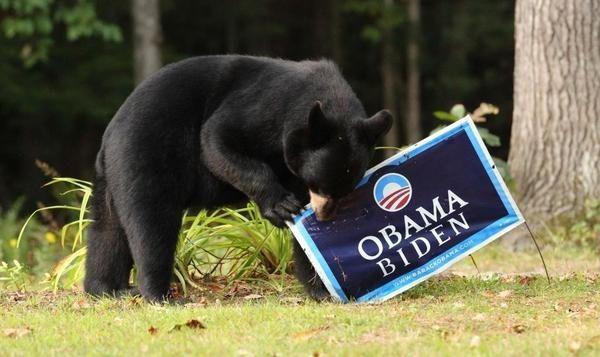The Wrack
The Wrack is the Wells Reserve blog, our collective logbook on the web.
The Wrack is the Wells Reserve blog, our collective logbook on the web.

The following was published in the Biddeford-Saco Journal Tribune Sunday edition, 11/2/2014.
From reports, it sounds like this year’s midterm election is a doozy, money-wise: across the country, campaigns are spending record sums marketing their candidates and causes. So I read, anyway: I do not watch broadcast TV, I have an ad blocker on my computer, and I only listen to satellite radio and MPBN. Voluntarily [and gratefully] deaf to the din from most of the marketing wars, I rarely hear about the latest advances in breakfast cereal, let alone the biannual election season onslaught.
About the only political advertising I do see are ads in newspapers (bless you, candidates, for feeding our starving print publishers), and outdoor campaign signs.
Like those invasive plants bittersweet and loosestrife, election signs still regularly invade and bloom in Maine. By this point in their season, it’s hard to see the grass on the traffic medians – even the panhandlers are hard pressed to find a place to stand.
Do political yard signs do anything more than clutter our streets and clog our drains? Perhaps fortunately for signmakers, the science behind them remains understudied. There is a marketing theory that contends that mere name recognition is what counts. It’s a theory based on the laziness of the American consumer: we tend to buy what we’re familiar with, be it breakfast cereal, car insurance, or candidates.
The simple red and blue coding for party affiliation helps the uninformed voter too – if I’m a (D), I should vote for the name I remember from blue signs, (R) for red. (Third parties and independents, as always, have an uphill climb, and our democracy suffers for it.) However effective they are, on November 5th, it’s off to the landfill for all those signs. What a short and pointless life.
I’ve tried to inoculate myself to political advertising in and out of the home. Instead of helping to line the pockets of political consultants and TV station owners, I track candidates and campaigns through the Tampa Bay Times’s Politifact.com and the Annenberg Center’s Factcheck.org. These two Internet sites have less interest in covering the biannual political horse race of poll numbers and campaign spending than in pointing out the white lies, damned lies, and statistics told by competing campaigns, and I value their coverage.
Alas, our cul-de-sac state, with its four electoral votes and generally sleepy races, doesn’t get much attention. The studious Maine voter is left to other devices this go-round. Ultimately, I'll make my choice by voting for the person, gleaning what I can from our state’s political journalists, debate recaps, newspaper endorsements, friends, and lots of reading. And after all that, I'm sure I'll still end up having “buyer’s remorse” for some of the politicians I meet and vote for.
I must admit, I’m more comfortable voting for policies and bonds, issues I can judge on the supposed facts alone. This year, Maine has seven Questions on the ballot, seeking a total of $50 million in new borrowing. In general, I think buying on credit is always a good idea when interest rates are this low: the money is more useful in the system than out, and the returns on investment don’t have to be that high to break even.
Questions 2 through 7 all seek public funds for new laboratories, small business loans, scientific research, and infrastructure projects. These are the kinds of projects that pay off economically and socially. The staff here at the Wells Reserve at Laudholm, a place devoted to clean water, a healthy coast, and environmental conservation, helped draft the early versions of the “Water Bond,” which now seeks $10 million for water quality projects statewide through Question 6. I, for one, prefer swimming in the ocean over pools, and drinking my water from the tap, not the bottle, so I’m all for this one. Anything that will deal with long-term water issues, in this disrupted century of rain and drought and freshwater access, is smart strategy. Plus, Maine will get an additional $21 million in federal matching money, so the bond in Question 6 will go thrice as far.
Question 1, on bears and their baiting, is the only question I’ve really spent time questioning. I’ve read both sides, heard from game wardens, biologists, hunters and animal rights defenders. Bear baiting, trapping, and hounding are inhumane, yes, but humans are always inhumane to supposedly lesser species. From what I can tell, with less hunting we will have more hungry bears, closer to polite society. That doesn’t sound good for bears or humans in the long run. If we are intent on living in bear country, we must trust those who manage those areas to know what coexistence requires.
I work at a scientific institution, and on Tuesday, my vote will land on the side of science. Science is not perfect, but at least it is systematic. My colleagues and I are continually frustrated by those who misuse or ignore data; I cannot be guilty of the same. I vote ‘no’ on Question 1, with the hope that those who ask us to “Trust the Wildlife Biologists” this year will also, when the time comes, remember to trust the climate scientists as well.
Nik Charov is president of Laudholm Trust, the nonprofit partner of the Wells National Estuarine Research Reserve in Wells, Maine. His Sunday column, “Between Two Worlds,” ventures forth from the intersection of art and science, past and future, policy and impolitic. More at wellsreserve.org/twoworlds.